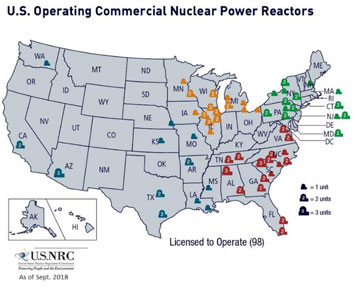Backgrounder on Analysis of Cancer Risks in Populations Near Nuclear Facilities
Printable Version
On this page:
Background
Nuclear Regulatory Commission-licensed facilities sometimes release very small amounts of radiation during normal operations. Facility operators must follow NRC regulations by closely monitoring and controlling these releases to meet very strict radiation dose limits. The plants also must publicly report them to the agency. These reports continue to support the conclusion U.S. nuclear power plants do not affect public health and safety. Nevertheless, some people are concerned these very small releases could affect health in communities around nuclear facilities.
In 2010, the NRC sought to address these concerns by asking the National Academy of Sciences to perform a state-of-the-art study on cancer risk for populations surrounding NRC-licensed facilities (see map). In 2015, the NRC ended the project after concluding the work had a low likelihood of getting usable results in a reasonable time frame.
The NAS study would have examined nuclear power plants and certain plants that create the nuclear fuel used in the power plants. The NAS effort aimed at creating an up-to-date, more thorough examination of cancer incidence than a 1990 U.S. National Institutes of Health- National Cancer Institute report, “Cancer in Populations Living Near Nuclear Facilities.” The 1990 NCI report concluded that cancer mortality rates were the same whether a reactor was nearby or not. The NRC staff continues to use the NCI report as a primary resource during public discussions of the cancer risk in communities near nuclear facilities.
NRC Request and Results of Phase 1
The NRC and NAS agreed on a two-phase approach. The NAS Phase 1 committee’s May 2012 report recommended two approaches for assessing cancer risks. The committee also recommended a pilot study of seven nuclear facilities to assess whether the approaches could work on a larger scale−this would be the Phase 2 pilot study.
The Phase 1 committee identified many technical challenges for the pilot study, including:
- The need for large groups of people to detect very small changes in risk.
- Uneven availability and quality of cancer data for areas smaller than a county.
- Difficulty in reliably capturing information on population movement, risk factors and other variables that could make interpreting the results difficult.
The pilot study would show if these technical challenges could be overcome. It would also develop procedures and data collection methods and help with estimating the necessary time and resources for a full-scale study.
The Phase 1 committee specifically recommended the pilot study have two parts: a population study of cancer diagnosis and mortality rates for multiple cancer types and all age groups, and a “case control” study of childhood cancers in children born within a fixed distance of a nuclear facility.
NRC-regulated facilities record information on their releases and report it once a year to the NRC. The committee recommended using this data and examining populations within about 30 miles of nuclear facilities to cover a range of potential radiation exposures. The committee also recommended adapting existing computer models (or developing a new model) to estimate radiation doses to individual organs from airborne and liquid radioactive releases.
The NAS committee recommended these facilities for the pilot study:
- Dresden Nuclear Power Station, Illinois.
- Millstone Power Station, Connecticut.
- Oyster Creek Nuclear Generating Station, New Jersey.
- Haddam Neck, Connecticut (decommissioned).
- Big Rock Point Nuclear Power Plant, Michigan (decommissioned).
- San Onofre Nuclear Generating Station, California (permanently shut down).
- Nuclear Fuel Services, Tennessee.
These facilities were selected because they started operation at different times and represent both currently operating and decommissioned nuclear facilities. Moreover, these facilities would offer variation in surrounding population sizes, the quality and maturation of the state’s cancer registry, and level of complexity for the registry’s research approval processes and research support.
Phase 2 Development
The NRC accepted the NAS recommendations and asked the NAS to carry out the pilot study. NAS started the pilot planning phase in September 2013. The pilot study proposal had two steps: planning and execution. Planning activities included appointing the study committee; assessing the availability and quality of release and weather data; and identifying state requirements for data sharing and transfer of health information. Execution phase activities would include obtaining weather and release data; turning the information into computer files that can be used for dose estimation; obtaining cancer incidence and mortality data to determine whether the population study could be carried out; and developing processes for public participation and communication.
Project Closeout
NRC staff examined the NAS Phase 2 report, which said the pilot study was unlikely to answer the basic risk question because “any data collected during the pilot study will have limited use for estimating cancer risks in populations near each of the nuclear facilities or for the seven nuclear facilities combined because of the imprecision inherent in estimates from small samples.”
The NAS concluded they would need more than three years and $8 million to complete the pilot study. If the pilot succeeded, expanding the research to all U.S. operating reactors would require additional years and tens of millions of dollars. The NRC ultimately decided the time and money would not be well spent for the possible lack of useful results. The NRC agrees with the NAS that the study’s approach is scientifically sound. The NAS Phase 1 and 2 reports have more detailed discussions of the methods and resources needed to conduct the proposed study.
The NRC staff continues to monitor international and national studies on cancer risk. For example, the agency’s 2023 Regulatory Information Conference included a session on long-term studies of a million workers whose radiation doses were closely monitored. These studies indicate the current system of radiation protection adequately protects the health and safety of workers and the general public.
April 2024
Page Last Reviewed/Updated Thursday, April 04, 2024